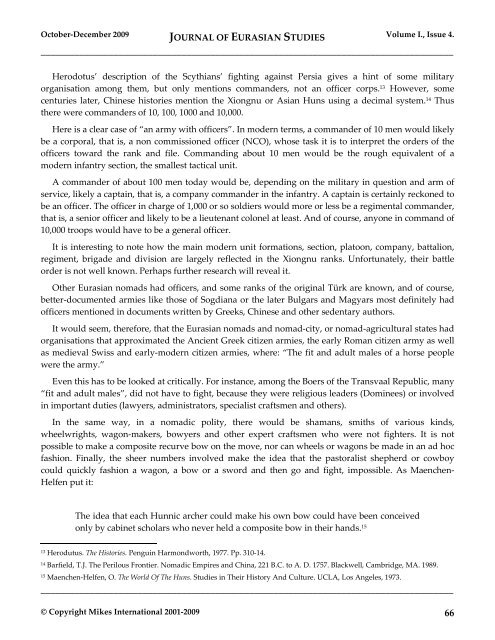JOURNAL OF EURASIAN STUDIES
JOURNAL OF EURASIAN STUDIES
JOURNAL OF EURASIAN STUDIES
Create successful ePaper yourself
Turn your PDF publications into a flip-book with our unique Google optimized e-Paper software.
October-December 2009 <strong>JOURNAL</strong> <strong>OF</strong> <strong>EURASIAN</strong> <strong>STUDIES</strong> Volume I., Issue 4.<br />
_____________________________________________________________________________________<br />
Herodotus’ description of the Scythians’ fighting against Persia gives a hint of some military<br />
organisation among them, but only mentions commanders, not an officer corps. 13 However, some<br />
centuries later, Chinese histories mention the Xiongnu or Asian Huns using a decimal system. 14 Thus<br />
there were commanders of 10, 100, 1000 and 10,000.<br />
Here is a clear case of “an army with officers”. In modern terms, a commander of 10 men would likely<br />
be a corporal, that is, a non commissioned officer (NCO), whose task it is to interpret the orders of the<br />
officers toward the rank and file. Commanding about 10 men would be the rough equivalent of a<br />
modern infantry section, the smallest tactical unit.<br />
A commander of about 100 men today would be, depending on the military in question and arm of<br />
service, likely a captain, that is, a company commander in the infantry. A captain is certainly reckoned to<br />
be an officer. The officer in charge of 1,000 or so soldiers would more or less be a regimental commander,<br />
that is, a senior officer and likely to be a lieutenant colonel at least. And of course, anyone in command of<br />
10,000 troops would have to be a general officer.<br />
It is interesting to note how the main modern unit formations, section, platoon, company, battalion,<br />
regiment, brigade and division are largely reflected in the Xiongnu ranks. Unfortunately, their battle<br />
order is not well known. Perhaps further research will reveal it.<br />
Other Eurasian nomads had officers, and some ranks of the original Türk are known, and of course,<br />
better-documented armies like those of Sogdiana or the later Bulgars and Magyars most definitely had<br />
officers mentioned in documents written by Greeks, Chinese and other sedentary authors.<br />
It would seem, therefore, that the Eurasian nomads and nomad-city, or nomad-agricultural states had<br />
organisations that approximated the Ancient Greek citizen armies, the early Roman citizen army as well<br />
as medieval Swiss and early-modern citizen armies, where: “The fit and adult males of a horse people<br />
were the army.”<br />
Even this has to be looked at critically. For instance, among the Boers of the Transvaal Republic, many<br />
“fit and adult males”, did not have to fight, because they were religious leaders (Dominees) or involved<br />
in important duties (lawyers, administrators, specialist craftsmen and others).<br />
In the same way, in a nomadic polity, there would be shamans, smiths of various kinds,<br />
wheelwrights, wagon-makers, bowyers and other expert craftsmen who were not fighters. It is not<br />
possible to make a composite recurve bow on the move, nor can wheels or wagons be made in an ad hoc<br />
fashion. Finally, the sheer numbers involved make the idea that the pastoralist shepherd or cowboy<br />
could quickly fashion a wagon, a bow or a sword and then go and fight, impossible. As Maenchen-<br />
Helfen put it:<br />
The idea that each Hunnic archer could make his own bow could have been conceived<br />
only by cabinet scholars who never held a composite bow in their hands. 15<br />
13 Herodutus. The Histories. Penguin Harmondworth, 1977. Pp. 310-14.<br />
14 Barfield, T.J. The Perilous Frontier. Nomadic Empires and China, 221 B.C. to A. D. 1757. Blackwell, Cambridge, MA. 1989.<br />
15 Maenchen-Helfen, O. The World Of The Huns. Studies in Their History And Culture. UCLA, Los Angeles, 1973.<br />
_____________________________________________________________________________________<br />
© Copyright Mikes International 2001-2009 66
















